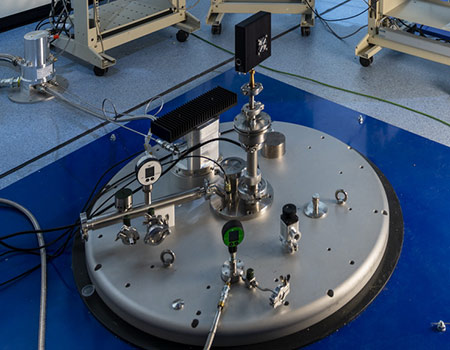A new standard for the ampere: LNE presents a major breakthrough in metrology
After eight years of work, LNE researchers have developed a new electric current quantum standard to realise the ampere unit in accordance with the 2018 SI definition. These results were published on 10 February 2025 in Nature Communications.

Objective: Realising the 2018 Ampere
In 2018, the base units of the International System of Units (SI) were redefined by fixing the numerical values of seven physical constants. The ampere, the base unit for electrical measurements, is now related to the elementary charge, e. Previously, and since 1948, its definition was based on Ampère’s law, which related the electrical current unit to the newton, the unit of force. The realisation of standards based on this earlier definition required electromechanical experiments. And these means could not provide the required uncertainties as expressed by users to the national electrical metrology institutes. Consequently, for several decades before 2018 and still today, electrical current measurements have been indirectly traceable through measurements of capacitance, voltage, and resistance—the best uncertainties of which are in the 10–8 range or even lower. This indirect, time-consuming and complex to implement traceability chain ultimately limits the uncertainty of realisation of the ampere to 10–6.
Moreover, with the advent of nanotechnologies in electronics, numerous research efforts worldwide have been and continue to be devoted to developing current generation systems that enable metrologists to control the transfer of electrons one by one. This approach would allow the ampere to be realised from a defined flux of elementary charges, in line with its definition. However, these “single-electron” systems only generate extremely weak currents—below the nanoampere level—with a quantification uncertainty exceeding 10–7, whereas the current requirement is of the order of 10–8.
To achieve such a low uncertainty in realising the ampere, LNE’s “Fundamental Electricity” team embarked in 2016 on an alternative approach. They developed an experiment to apply Ohm’s law directly to quantum standards of voltage and resistance, obtained respectively through the implementation of the Josephson Effect and the Quantum Hall Effect. Since 2019—the effective date of the 2018 SI definitions—these two quantum phenomena directly realise the volt and the ohm from Planck’s constant and the elementary charge. As a result, the experiment developed at LNE now realises the definition of the ampere using a Programmable Quantum Current Generator (PQCG).
Currently, the infrastructure comprises five quantum devices, judiciously connected to form a quantum current standard. In 2024, measurements demonstrated a considerable improvement in the quantified current generation system. The publication* on 10 February 2025 in Nature Communications presents these new results.
LNE’s PQCG now enables the generation of an electrical current over a wide range of values—typically between 1 µA and several milliamperes—with enhanced traceability to the ampere, making it a unique piece of primary metrology equipment.
For further information
- On the research work: refer to the press release (in french only).
- On the experimental results: see tharticle published in Nature Communications.
* S. Djordjevic, R. Behr and W. Poirier, “A primary quantum current standard based on the Josephson and quantum Hall effects”, Nat. Commun., (2025), 16, 1447, DOI: 10.1038/s41467-025-56413-9





